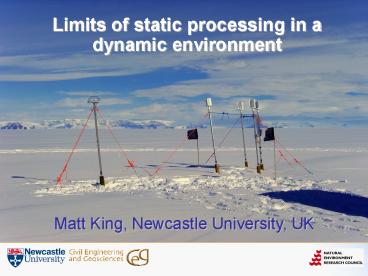Limits of static processing in a dynamic environment - PowerPoint PPT Presentation
Title:
Limits of static processing in a dynamic environment
Description:
Limits of static processing in a dynamic environment. Matt King, Newcastle ... How does a ~1m/day signal 1 hr static' solutions propagate into the parameters? ... – PowerPoint PPT presentation
Number of Views:25
Avg rating:3.0/5.0
Title: Limits of static processing in a dynamic environment
1
- Limits of static processing in a dynamic
environment
Matt King, Newcastle University, UK
2
Static Processing
- Good for these examples
3
Static Processing
- But what about this?
Detrended
5 min positions
Whillans Ice Stream
4
Background
- Common GPS processing approaches in glaciology
- Kinematic approach
- Antenna assumed moving constantly
- Coordinates at each and every measurement epoch
- Kinematic solutions often difficult due to long
between-site differences - Quasi-static approach
- Antenna assumed stationary for certain periods
(0.5-24h) - 24h common for solid earth
- lt4h common for glaciology
- But is this always valid?
5
GPS Data Processing Approaches
- Quasi-static
- Kinematic
- Quasi-static assumption is that site motion
during each session is averaged out
0.5-24h
White noise or random walk model
6
Motion and Least Squares
- Functional model
- Should fully describe the relationship between
parameters X and observation l with normally
distributed residuals v - F(X)l v
- Stochastic model
- Can attempt to mitigate or account for functional
model deficiencies - Unmodelled (i.e., systematic) errors will
propagate according to the geometry of the
solution - Station-satellite geometry
- Estimated parameters (e.g., undifferenced
Precise Point Positioning solutions vs
double-differenced ambiguity fixed vs ambiguity
float)
7
Systematic Error Propagation
- Estimated parameters
- Station coordinates (X,Y,Z)
- AND real-valued phase ambiguity (N) parameters
- Clock errors differenced out (in double
difference solutions) - Once ambiguities estimated, statistical tests
applied to fix to integers - Fixing not always possible
- Site motion could induce incorrect ambiguity
fixing
8
Real vs ImaginaryExample on the Amery Ice Shelf
GAMIT 1hr quasi-static solutions
Track Kinematic solution
King et al., J Geodesy, 2003
9
Whats happening?
- Presence of motion during static sections
- Violates least-squares principle of normal
residuals - Leads to biased parameter estimates
- Simulation
- How does a 1m/day signal and 1m tidal signal in
1 hr static solutions propagate into the
parameters? - Real broadcast GPS orbits
- Precise Point Positioning approach simulated
- Site 70S
10
Whats happening?
Ambiguity estimates mapped
Latitude
North (m)
Ambiguities fixed
East (m)
Height (m)
Ambiguities not fixed
Satellites East of site
Ambiguity (m)
11
Horizontal Motion Only
- GAMIT 1h solutions over modified zero baseline
Period related to satellite pass time?
0N
90S
12
Horizontal Motion Only
- Simulation grounded case
- How does a 1m/day signal 1 hr static solutions
propagate into the parameters? - Various flow directions (N, NE, E)
- 1hr solutions
- Various latitudes
- Site 70S
13
Whats Happening?
Ambiguity estimates mapped
North (m)
Ambiguities fixed
Ambiguities not fixed
East (m)
Height (m)
King et al., J Glac., 2004
14
Whillans Ice Stream
- Based on simulation would expect
- Agreement during stick
- Biases during slip
- But not in kinematic solutions
4hr quasi-static solutions
5min kinematic solutions
15
Response to tidal forcing how much is real?
- Rutford Ice Stream (W Antarctica) experiences
tidal modulation of its flow - How much of this signal is real?
Rutford Ice Stream
Window considered here
16
Response to tidal forcing how much is real?
- Two processing approaches
- Precise point positioning (GIPSY)
- Relative to a base station (Track), 30km away
- Tidal decomposition of de-trended along-flow
velocity - PPP very large response at high frequencies
from little downstream vertical forcing - e.g., M2 vertical tide 1.5m 2SK5 probably
lt0.05m
GIPSY (PPP)
17
Response to tidal forcing how much is real?
- Relative vs PPP
- LF (fortnightly) terms in good agreement
- Relative processing HF terms not sig.
GIPSY (PPP) and Track (relative)
18
Response to tidal forcing how much is real?
- Relative vs PPP
- In relative processing, smaller diurnal and
semi-diurnal vertical tide terms not significant - Same data
- Why the differences?
GIPSY (PPP) and Track (relative)
19
Response to tidal forcing how much is real?
- Relative processing is rover minus base (TOLL)
- How much signal is being differenced by the base?
- Gives tidal error spectrum for SEI1
- HF signal evident at base station on rock
- Common GPS satellite position biases?
- Care needed in interpreting HF velocity signals
in glaciological GPS time series - LF velocity signals are reliable in all solutions
20
Solid Earth Issues
- Propagation of mis/un-modelled periodic signals
(e.g., ocean tide loading displacements) in 24h
solutions - Well described by Penna Stewart (GRL, 2003) and
Penna et al., JGR, 2007. - Admittances in float ambiguity PPP solutions up
to 120 in worst case (S2 north component into
local up) - Depends on coordinate component of mismodelled
signal frequency geometry - Output frequencies depend on input frequency
- Annual, semi-annual and fortnightly, amongst many
others
21
Periodic Signals
mm
Penna et al., JGR, 2007
22
Effect in real data
- King et al, GRL, 2008
23
Conclusions
- Biases may exist in positions on moving ice from
GPS - Up to 40-50 of unmodelled vertical signal
- Up to 10 of unmodelled horizontal signal
- May be offsets, periodic signals or both in east,
north and height components - Height biases of concern when validating Lidar
missions - Periodic signals may result in wrong
interpretation as tidal modulation (or
contaminate real tidal modulation) - To measure bias-free ice motion using GPS
- Fix ambiguities to correct integers (not always
possible) - Use kinematic solution (may require
non-commercial software) - For 24h solutions
- Periodic signals propagate
- Other sub-daily signals (e.g., multipath) need
further study































